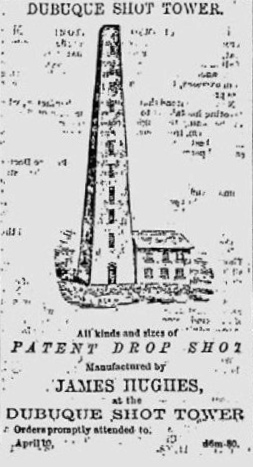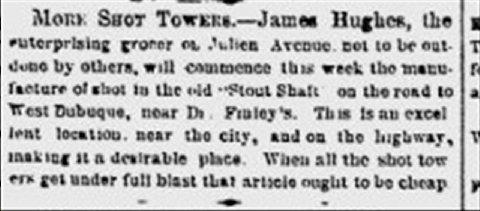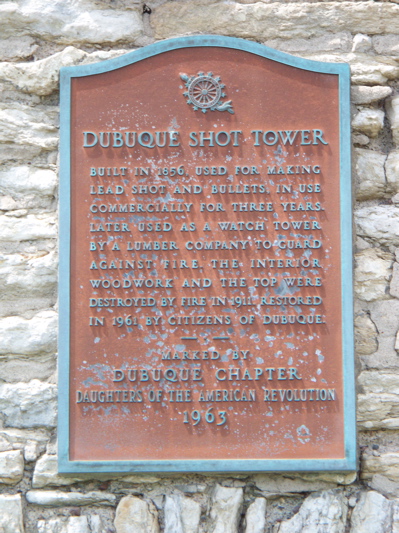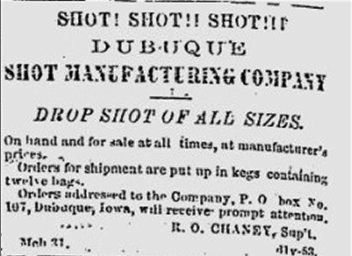Encyclopedia Dubuque
"Encyclopedia Dubuque is the online authority for all things Dubuque, written by the people who know the city best.”
Marshall Cohen—researcher and producer, CNN
Affiliated with the Local History Network of the State Historical Society of Iowa, and the Iowa Museum Association.
SHOT TOWER: Difference between revisions
No edit summary |
No edit summary |
||
| Line 4: | Line 4: | ||
The shot tower of George W. Rogers & Co. stood on an extension of Seventh street. Rising to a height of about 150 feet — 142 feet of stone and 42 of brick, the tower's base was 18 feet 10 inches. At the base walls were three feet thick and twenty inches at the top. The cost of construction by 1856 was $7000.00 and would rise eventually to $10,000. When completed, the tower could be used to produce from six to eight tons of shot. (3.) | The shot tower of George W. Rogers & Co. stood on an extension of Seventh street. Rising to a height of about 150 feet — 142 feet of stone and 42 of brick, the tower's base was 18 feet 10 inches. At the base walls were three feet thick and twenty inches at the top. The cost of construction by 1856 was $7000.00 and would rise eventually to $10,000. When completed, the tower could be used to produce from six to eight tons of shot. (3.) | ||
As soon as it was built and operating, the tower threatened the monopoly over shot production enjoyed by | As soon as it was built and operating, the tower threatened the monopoly over shot production enjoyed by Chadbourne and Foster of St. Louis, Missouri. The St. Louis company began by cutting their prices and then actually selling below cost. (4) This drove Rogers and Company out of business. The tower was leased to Pelig Tallman and Company for several months before they too quit. (5) | ||
The tower then became the property of [[GRAVES, Julius H.|Julius H. GRAVES]] and a group of Dubuque investors. Graves retaliated by encouraging buyers to purchase their shot from Chadbourne and Foster. (6) Since they were selling below their cost of production, this place a huge financial burden on the company. In the meantime, Graves was having his own problems in Dubuque. His shareholders were not making the profits they expected and were tired of battling the St. Louis company. Graves began buying up their stock for five cents on the dollar. (7) | |||
In 1860 on the verge of the [[CIVIL WAR]], representatives of Chadbourne and Foster came to Dubuque to buy out their competition. After negotiating with them, Graves was able to sell all his shares for fifty cents on the dollars making him a small fortune. (8) Part of the agreement stipulated that Graves could not make shot from a tower again in the area. | |||
Producing shot in mines had been done since 1831 in Wisconsin. (9) Graves was undoubtedly aware of the practice and repeated it north of Dubuque. Chadbourne and Foster sued claiming Graves had violated his contract. He responded that he had not used a tower and won the case. Defeated, the company of Chadbourne and Foster left Dubuque without destroying the competition or the tower as they had suggested. (10) | |||
| Line 32: | Line 38: | ||
3. Oldt, Franklin T. History of Dubuque County. http://www.ebooksread.com/authors-eng/franklin-t-oldt/history-of-dubuque-county-iowa-being-a-general-survey-of-dubuque-county-histor-tdl/page-13-history-of-dubuque-county-iowa-being-a-general-survey-of-dubuque-county-histor-tdl.shtml | 3. Oldt, Franklin T. History of Dubuque County. http://www.ebooksread.com/authors-eng/franklin-t-oldt/history-of-dubuque-county-iowa-being-a-general-survey-of-dubuque-county-histor-tdl/page-13-history-of-dubuque-county-iowa-being-a-general-survey-of-dubuque-county-histor-tdl.shtml | ||
4. "Old Shot Tower, Now In Ruins, on Standard Lumber Company's Grounds, and Its Unique History, Telegraph Herald, April 5, 1914, p. 13. Online: http://news.google.com/newspapers?id=j3FiAAAAIBAJ&sjid=AncNAAAAIBAJ&pg=4259,7228461&dq=shot+manufacturing+dubuque&hl=en | |||
4. McDermott, Brad. "Shot Spot," Telegraph Herald, August 22, 1996, p. 1. Online: http://news.google.com/newspapers?id=IvBQAAAAIBAJ&sjid=ursMAAAAIBAJ&pg=5295,4046499&dq=shot+manufacturing+dubuque&hl=en | 4. McDermott, Brad. "Shot Spot," Telegraph Herald, August 22, 1996, p. 1. Online: http://news.google.com/newspapers?id=IvBQAAAAIBAJ&sjid=ursMAAAAIBAJ&pg=5295,4046499&dq=shot+manufacturing+dubuque&hl=en | ||
Revision as of 01:33, 6 November 2013
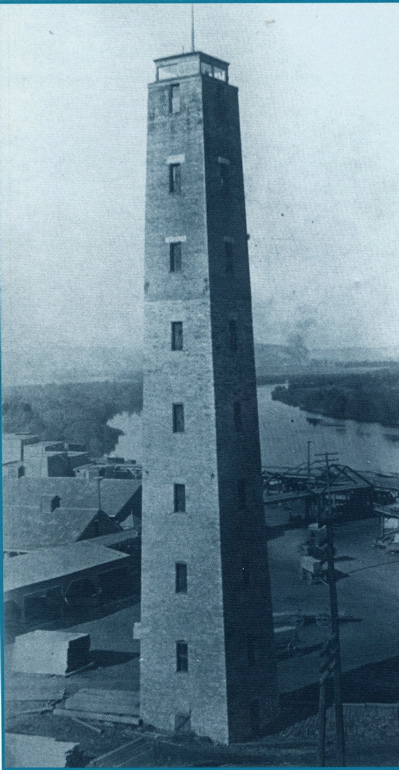
SHOT TOWER. The process of producing lead SHOT with a tower for military or individual ammunition was patented by William Watts on September 28, 1782. (1) Lead was heated until molten and then dropped through a copper sieve high in the tower. The liquid lead solidified as it fell and by surface tension formed tiny spheres. The partially cooled balls were caught at the floor of the tower in a water-filled basin. The fully cooled balls were checked for roundness and sorted by size; those that are "out of round" were remelted. A slightly inclined table was used for checking roundness. To make larger shot sizes, a copper sieve with larger holes was used. The maximum size was limited by the height of the tower; larger shot sizes must fall farther to cool. (2)
The shot tower of George W. Rogers & Co. stood on an extension of Seventh street. Rising to a height of about 150 feet — 142 feet of stone and 42 of brick, the tower's base was 18 feet 10 inches. At the base walls were three feet thick and twenty inches at the top. The cost of construction by 1856 was $7000.00 and would rise eventually to $10,000. When completed, the tower could be used to produce from six to eight tons of shot. (3.)
As soon as it was built and operating, the tower threatened the monopoly over shot production enjoyed by Chadbourne and Foster of St. Louis, Missouri. The St. Louis company began by cutting their prices and then actually selling below cost. (4) This drove Rogers and Company out of business. The tower was leased to Pelig Tallman and Company for several months before they too quit. (5)
The tower then became the property of Julius H. GRAVES and a group of Dubuque investors. Graves retaliated by encouraging buyers to purchase their shot from Chadbourne and Foster. (6) Since they were selling below their cost of production, this place a huge financial burden on the company. In the meantime, Graves was having his own problems in Dubuque. His shareholders were not making the profits they expected and were tired of battling the St. Louis company. Graves began buying up their stock for five cents on the dollar. (7)
In 1860 on the verge of the CIVIL WAR, representatives of Chadbourne and Foster came to Dubuque to buy out their competition. After negotiating with them, Graves was able to sell all his shares for fifty cents on the dollars making him a small fortune. (8) Part of the agreement stipulated that Graves could not make shot from a tower again in the area.
Producing shot in mines had been done since 1831 in Wisconsin. (9) Graves was undoubtedly aware of the practice and repeated it north of Dubuque. Chadbourne and Foster sued claiming Graves had violated his contract. He responded that he had not used a tower and won the case. Defeated, the company of Chadbourne and Foster left Dubuque without destroying the competition or the tower as they had suggested. (10)
In response to the tower, the St. Louis firm cut its prices below the cost of production to destroy their Dubuque competitor. Despite lease of the tower to the Pelig Tallman Company in 1859 and new management by Langworthy and Cook, discouraged stockholders sold their shares to Julius K. GRAVES for as little as five cents on the dollar. Graves threatened to resume shot production and then sold his shares to Chadburne and Forster for fifty cents on the dollar.
Graves resumed the production of shot after finding a deep mine shaft into which the molten lead could be poured. He was sued by Chadburne and Forster for breaking a contract that he would not manufacture shot within one hundred miles of Dubuque.
Graves' plan was apparently a popular one. As indicated in the article from the Dubuque-Herald of August 5, 1862, other enterprising Dubuque residents copied his ingenious idea. Graves was found innocent because he had not used a shot tower in the process. The St. Louis firm then abandoned the tower and their attempts to silence their Dubuque competitors.
A statue of Andrew Jackson was placed on the tower by John Deery in 1874 and was not removed until 1881. The STANDARD LUMBER COMPANY used the tower, with a glass-enclosed shelter on the top, to safeguard up to seven blocks of lumber.
Disastrous fires set by arsonists in 1911 ruined the company and destroyed the inner wooden framework of the tower.
Abandoned to the elements, the tower deteriorated. In 1959 concerned citizens rallied behind an S.O.S. (Save Our Shot Tower) campaign. Canisters were placed in restaurants and stores asking for money. When the drive ended in February 1960, $6,700 had been contributed including $25 from U. S. Grant III, the grandson of the CIVIL WAR general. The Dubuque City Council appropriated $5,000. Repairs, including tuck pointing both the interior and exterior and repairing the windows, were estimated to cost $11,000.
In 1996 officials suggested that the tower should be moved. (4) For the safety of visitors, a consultant suggested disassembling the tower and rebuilding it just south of the DUBUQUE STAR BREWING COMPANY as part of the proposed riverwalk project. In addition to the unknown cost of moving the tower, concerns were raised as to whether the relocation would cause the tower to lose its listing on the NATIONAL REGISTER OF HISTORIC PLACES. (5)
Source:
1. Minchinton, Walter. "Lead Shot Towers Around the World," History Today, November 5, 2013. Online: http://www.historytoday.com/walter-minchinton/lead-shot-towers-around-world
2. "Shot Tower Lead-Melting Bowl," Wisconsin Historical Society. Online: http://www.wisconsinhistory.org/museum/artifacts/archives/003290.asp
3. Oldt, Franklin T. History of Dubuque County. http://www.ebooksread.com/authors-eng/franklin-t-oldt/history-of-dubuque-county-iowa-being-a-general-survey-of-dubuque-county-histor-tdl/page-13-history-of-dubuque-county-iowa-being-a-general-survey-of-dubuque-county-histor-tdl.shtml
4. "Old Shot Tower, Now In Ruins, on Standard Lumber Company's Grounds, and Its Unique History, Telegraph Herald, April 5, 1914, p. 13. Online: http://news.google.com/newspapers?id=j3FiAAAAIBAJ&sjid=AncNAAAAIBAJ&pg=4259,7228461&dq=shot+manufacturing+dubuque&hl=en
4. McDermott, Brad. "Shot Spot," Telegraph Herald, August 22, 1996, p. 1. Online: http://news.google.com/newspapers?id=IvBQAAAAIBAJ&sjid=ursMAAAAIBAJ&pg=5295,4046499&dq=shot+manufacturing+dubuque&hl=en
5. Ibid.


